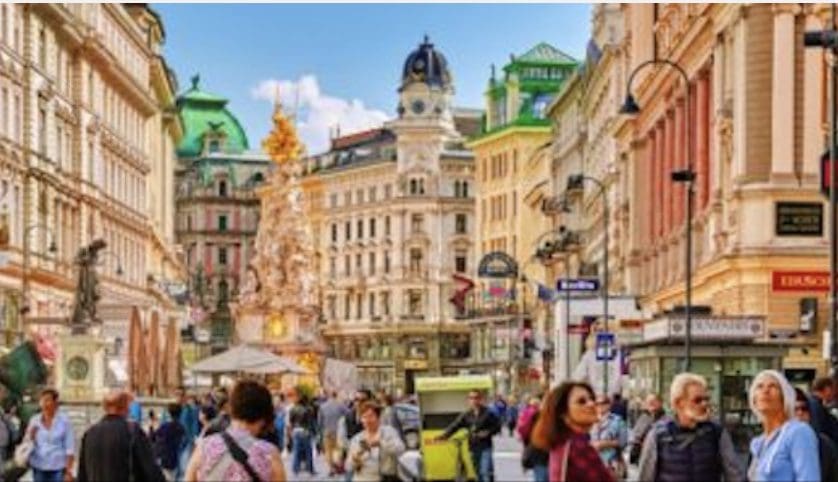Search Posts
Recent Posts
- Outdoors in RI: 138th Arbor Day, Princess Kate and access to nature, Winnapaug Pond, Vets fish April 18, 2025
- Saving lives, Paul Rego donates his 100th gallon of blood at the Rhode Island Blood Center April 18, 2025
- Rhode Island Weather for April 18, 2025 – Jack Donnelly April 18, 2025
- National Financial Literacy Month. BankRI offers free, virtual workshop: “Smart money moves… April 18, 2025
- GriefSpeak. Technology in Death and Grief – Mari Nardolillo Dias April 18, 2025
Categories
Subscribe!
Thanks for subscribing! Please check your email for further instructions.

A year in architecture – reaffirming the comfort of traditional design for the world – David Brussat
by David Brussat, Architecture Here and There – guest column by Michael Diamant
Photo: Image of European street scene
Below is a guest column by Michael Diamant, a connoisseur of architecture living in Stockholm and founder, in 2012, of the website New Traditional Architecture. He is expected to participate in the annual meeting of the Traditional Architecture Gathering set for Feb. 26-28 on Zoom. It is sponsored by Nir Buras of the Classic Planning Institute and Patrick Webb of the American College of the Building Arts. Diamant replied as follows to my request, on behalf of TAG 4, for information on trends in Europe.
***
In general I see things going more or less the same way as the last year. A handful of very excellent projects, a much larger number of general or mediocre ones. The wheel tracks of each individual country have moved little. Somehow, no country in Europe can have it all, but generally they are good in one area.
Germany: Good in scale and proportion but generally very strict, white and with little or no ornamentation. Problem here is a lack of growth in the number of new classical architects, despite an active countrywide organisation promoting new classical and new traditional.
Russia: The most creative architects here work under municipalities that are bad at upholding regulations. Russian building projects are forced by developers to be over-dimensioned, ruining streetscapes and aesthetics despite talent, creative decoration and ornamentation. But as individual architects they really push things forward and are talented and creative.
UK: Excellent projects in both scale and quality, but quite boring and zero push forward. I fear the 19th century will never end there.
France: The best at tradtional urbanism by far. New traditional architecture is very common but in the form of low quality “construction company classicism.” Scale is excellent and streetscapes are improved, but as individual projects they are mostly pastiche, with typical modern balconies facing the street rather than the courtyard.
Hungary: A world of its own, as always. Many notable classical reconstruction projects and lots of new vernacular projects. Their own new Hungarian organic style (which is not as good as previous traditional styles) is quite popular with institutions. If their organic school would move towards more classical and traditional styles, this is the country where you would see the first complete return of classical instead of modernism.
Poland: Large-scale reconstruction and restoration projects. New buildings are vernacular and mostly private, suburban projects. Has the largest student body in Europe interested in becoming classical architects. May also become the first European country to have classical architecture as a program at university.
Belgium: Excellent new vernacular villas, a few high-quality multifamily projects in villages and the suburbs of larger cities. Dreadful modernist developments in the cities replacing classical architecture.
Sweden: The paradox: few new projects but the best national discourse. Building new classical is debated all the time in all the big newspapers. The new trend is municipalities demanding classical construction in their development plans. While this is good, lack of knowledge and expertise is a huge problem.
Netherlands: Reasonably abundant but very boring. Their best projects are the many urban repairs where they replace 1960s eyesores with traditional-looking designs.
These are the main players, but things are happening all over Europe. The positive thing that has come out of this past year is the increase in many places in knowledge of and interest in traditional design by the public and architects and architecture students. Students from places like Serbia, Croatia and Bosnia have contacted me to learn more about studying classical architecture. A summer school in classical architecture was started in Sweden four years ago and last year a summer school in classical architecture was started in Brussels.
Generally speaking, there will be little improvement in each country if they don’t learn more about what is happening in other countries so they can be inspired. The key is higher expectations by municipalities, I would say.
Regarding the U.S., Latin America, Australia and New Zealand things are of course moving forward. From my outsider perspective, the U.S. builds amazing projects yearly in lousy urban settings or in suburbia.
The dream would be if American architects could start building in European urban settings. In Latin America I would say that the biggest trend is that RAMSA [Robert A.M. Stern Architects] has established itself in Peru with their fourth and fifth multifamily project under construction. This North American thrust into Latin America cannot be understimated. You will problably see RAMSA designing projects (in their New York-style classicism) all over Latin America in the coming years, transforming the luxury market.
— Guest post by Michael Diamant
Read full column at: https://architecturehereandthere.com/2021/02/23/diamant-on-trad-in-europe/
_____

My freelance writing and editing on architecture and others addresses issues of design and culture locally and globally. I am a member of the board of the New England chapter of the Institute of Classical Architecture & Art, which bestowed an Arthur Ross Award on me in 2002. I work from Providence, R.I., where I live with my wife Victoria, my son Billy and our cat Gato. If you would like to employ my writing and editing to improve your work, please email me at my consultancy, [email protected], or call (401) 351-0457 https://architecturehereandthere.com/
